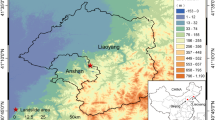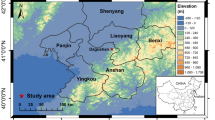Abstract
Owing to the heavy rainfall, a landslide occurred at the Anqian Iron mine, at 18:00(UTC + 8) on November 24, 2019, in China. The landslide was about 3.0 × 104 m3 and caused damage to the road of transporting waste materials. Failure characteristics and the mechanism of this landslide were analyzed in this study. The landslide area was divided into three parts: the rear tension cracking area, the middle sliding deformation area, and the front colluvium area. A contact-free measuring technique using the new ShapeMetrix3D system was applied and 204 joints were analyzed based on equal-angle stereographic projection. Thus, a conceptual model of the mechanism of the landslide was constructed and the formation process of the landslide was divided into three stages: the first shearing and dislocation stage; the second sliding, front bulging, and rear tractive cracking stage; and the third local rock mass collapse and colluvium depositing stage. Numerical modeling was performed to discover the landslide mechanism by progressively reducing the shear strength of rock mass. The results showed that the original slope was stable, whereas heavy rainfall triggered the landslide, and the predicted failure surface matched closely the field investigations. The factor of safety obtained by real three-dimensional analyses was slightly higher than that obtained by plane problem analyses, and the difference was attributed to the three-dimensional effect of the landslide. This paper also presents the results obtained from the parametric analysis in order to understand the impact of shear strength parameters on the overall stability of the slope.





















Similar content being viewed by others
Availability of data and material
All data and material used to support the findings of this study are included within the article.
Code accessibility
All code used to support the findings of this study are included within the article.
References
3G Software & Measurement GmbH (2020) ShapeMetriX3D 3D imaging for measuring and assessing rock and terrain surfaces, user Manual for version 4.4
Bruthans J, Soukup J, Vaculikova J, Filippi M, Schweigstillova J, Mayo AL, Masin D, Kletetschka G, Rihosek J (2014) Sandstone landforms shaped by negative feedback between stress and erosion. Nat Geosci 7:597–601
Chen SC, Chou HT, Chen SC, Wu CH, Lin BS (2014) Characteristics of rainfall-induced landslides in Miocene formations: a case study of the Shenmu watershed, Central Taiwan. Eng Geol 169:133–146
Cheng YM, Lansivaara T, Wei WB (2007) Two-dimensional slope stability analysis by limit equilibrium and strength reduction methods. Comput Geotech 34(3):137–150
Chung MC, Tan CH, Chen CH (2017) Local rainfall thresholds for forecasting landslide occurrence: Taipingshan landslide triggered by Typhoon Saola. Landslides 14:19–33
Deng JH, Tham LG, Lee CF, Yang ZY (2007) Three-dimensional stability evaluation of a preexisting landslide with multiple sliding directions by the strength-reduction technique. Can Geotech J 44(3):343–354
Ering P, Babu GLS (2016) Probabilistic back analysis of rainfall induced landslide-a case study of Malin landslide, India. Eng Geol 208:154–164
Fu WX, Liao Y (2010) Non-linear shear strength reduction technique in slope stability calculation. Comput Geotech 37:288–298
Griffiths DV, Marquez RM (2007) Three-dimensional slope stability analysis by elasto-plastic finite elements. Geotechnique 57(6):537–546
He MC, Feng JL, Sun XM (2008) Stability evaluation and optimal excavated design of rock slope at Antaibao open pit coal mine, China. Int J Rock Mech Min Sci 45(3):289–302
Hoek E, Brown ET (1980) Empirical strength criterion for rock masses. J Geotech Eng Div ASCE 106(9):1013–1035
Hoek E, Brown ET (1997) Practical estimates of rock mass strength. Int J Rock Mech Min Sci 34(8):1165–1186
Hoek E, Carranza-Torres C, Corkum B (2002) Hoek-Brown failure criterion – 2002 Edition. Proceedings of NARMS-TAC Conference, Toronto, Canada 267–273
Itasca Consulting Group (2017) FLAC3D user’s and theory manuals, version 6.0, Minneapolis
Iverson RM (2000) Landslide triggering by rain infiltration. Water Resour Res 36(7):1897–1910
Kwong AKL, Wang M, Lee CF, Law KT (2004) A review of landslide problems and mitigation measures in Chongqing and Hong Kong: similarities and differences. Eng Geol 76:27–39
Li Q, Wang YM, Zhang KB, Yu H, Tao ZY (2020) Field investigation and numerical study of a siltstone slope instability induced by excavation and rainfall. Landslides 17(6):1485–1499
Lin F, Wu LZ, Huang RQ, Zhang H (2018) Formation and characteristics of the Xiaoba landslide in Fuquan, Guizhou, China. Landslides 15(4):669–681
Mehdipour I, Ghazavi M, Moayed RZ (2013) Numerical study on stability analysis of geocell reinforced slopes by considering the bending effect. Geotext Geomembr 37:23–34
Moriwaki H, Inokuchi T, Hattanji T, Sassa K, Ochiai H, Wang G (2004) Failure process in a full-scale landslide experiment using a rainfall simulator. Landslides 1(4):277–288
Nie L, Li ZC, Zhang M, Xu L (2015) Deformation characteristics and mechanism of the landslide in West Open-Pit Mine, Fushun, China. Arab J Geosci 8(7):4457–4468
Pan Y, Wu G, Zhao ZM, He L (2020) Analysis of rock slope stability under rainfall conditions considering the water-induced weakening of rock. Comput Geotech 128:103806
Peng JB, Fan ZJ, Wu D, Zhuang JQ, Dai FC, Chen WW, Zhao C (2015) Heavy rainfall triggered loess-mudstone landslide and subsequent debris flow in Tianshui, China. Eng Geol 186:79–90
Priest SD (2005) Determination of shear strength and three-dimensional yield strength for the Hoek-Brown criterion. Rock Mech Rock Eng 38(4):299–327
Rahardjo H, Lim TT, Chang MF, Fredlund DG (1995) Shear strength characteristics of a residual soil. Can Geotech J 32(1):60–77
Rocscience Inc. (2004) RocData user’s guide, version 3.0, Toronto
Shen JY, Karakus M (2014) Three-dimensional numerical analysis for rock slope stability using shear strength reduction method. Can Geotech J 51(2):164–172
Shi GC, Yang XJ, Chen W, Chen H, Zhang JC, Tao ZG (2021) Characteristics of failure area and failure mechanism of a landslide in Yingjiang County, Yunnan, China. Landslides 18(2):721–735
Stead D, Wolter A (2015) A critical review of rock slope failure mechanisms: the importance of structure geology. J Struct Geol 74:1–23
Sun SW, Fu Z, Zhang K (2016) Stability of slopes reinforced with truncated piles. Adv Mater Sci Eng 2016:1570983
Sun SW, Wang YK, Pang B (2018) A method of 3D network modeling of discontinuities in rock slope. J Min Sci Tech 3(5):461–469 (in Chinese)
Troncone A, Conte E, Donato A (2014) Two and three-dimensional numerical analysis of the progressive failure that occurred in an excavation-induced landslide. Eng Geol 183:265–275
Tutluoglu L, Oge IF, Karpuz C (2011) Two and three dimensional analysis of a slope failure in a lignite mine. Comput Geosci 37(2):232–240
Ugai K (1989) A method of calculation of total factor of safety of slopes by elasto-plastic FEM. Soils Found 29(2):190–195
Ulusay R (2015) The ISRM suggested methods for rock characterization, testing and monitoring: 2007–2014. Springer-Verlag, Switzerland
Wang G, Sassa K (2001) Factors affecting rainfall-induced flowslides in laboratory flume tests. Geotechnique 51(7):587–599
Wei WB, Cheng YM, Li L (2009) Three-dimensional slope failure analysis by the strength reduction and limit equilibrium methods. Comput Geotech 36(1):70–80
Wu JH, Lin WK, Hu HT (2018) Post-failure simulations of a large slope failure using 3DEC: the Hsien-du-shan slope. Eng Geol 242:92–107
Wyllie DC (2018) Rock slope engineering: civil applications, 5th edn. Taylor & Francis Group, Boca Raton
Xu Q, Dong XJ, Liu HX (2011) Typical formation modes and mechanism of deep-seated rockslide triggered by heavy rainfall. J Chin Soil Water Conserv 42(4):291–302 (in Chinese)
Xu Q, Liu HX, Ran JX, Li WH, Sun X (2016) Field monitoring of groundwater responses to heavy rainfalls and the early warning of the Kualiangzi landslide in Sichuan Basin, southwestern China. Landslides 13(6):1555–1570
Yang J, Tao Z, Li B, Gui Y, Li H (2012) Stability assessment and feature analysis of slope in Nanfen Open Pit Iron Mine. Int J Min Sci Technol 22(3):329–333
Zezere JL, Trigo RM, Trigo IF (2005) Shallow and deep landslides induced by rainfall in the Lisbon region (Portugal): assessment of relationships with the North Atlantic Oscillation. Nat Hazards Earth Syst Sci 5(3):331–344
Zhang FY, Huang XW (2018) Trend and spatiotemporal distribution of fatal landslides triggered by non-seismic effects in China. Landslides 15(8):1663–1674
Zhang G, Qian JY, Wang R, Zhang JM (2011) Centrifuge model test study of rainfall-induced deformation of cohesive soil slopes. Soils Found 51(2):297–305
Zhang S, Xu Q, Hu ZM (2016) Effects of rainwater softening on red mudstone of deep-seated landslide, Southwest China. Eng Geol 204:1–13
Zhang S, Xu Q, Peng DL, Zhu ZX, Li WH, Wong HF, Shen P (2020) Stability analysis of rock wedge slide subjected to groundwater dynamic evolution. Eng Geol 270:105528
Zhao LH, Li DJ, Tan HH, Cheng X, Zuo S (2019) Characteristics of failure area and failure mechanism of a bedding rockslide in Libo County, Guizhou, China. Landslides 16(7):1367–1374
Zhou S, Ouyang CJ, An HC, Jiang TH, Xu QS (2020) Comprehensive study of the Beijing Daanshan rockslide based on real-time videos, field investigations, and numerical modeling. Landslides 17(5):1217–1231
Zienkiewicz OC, Humpheson C, Lewis RW (1975) Associated and nonassociated visco-plasticity and plasticity in soil mechanics. Geotechnique 25(4):671–689
Acknowledgements
We would like to express our gratitude to the editors and reviewers for their constructive and helpful comments.
Funding
Shu-wei Sun was supported by the National Key Research and Development Plan (No. 2017YFC1503103) and the National Natural Science Fund of China (No. 51574245).
Author information
Authors and Affiliations
Contributions
All authors contributed to this study. Shu-wei Sun and Bo Pang designed the research study. Shu-wei Sun and Jia-bing Hu analyzed the field data. Shu-wei Sun wrote this paper. Zhao-xi Yang and Xiao-yu Zhong reviewed the manuscript. All authors gave final approval for publication.
Corresponding author
Ethics declarations
Competing interests
The authors declare no competing interests.
Rights and permissions
About this article
Cite this article
Sun, Sw., Pang, B., Hu, Jb. et al. Characteristics and mechanism of a landslide at Anqian iron mine, China. Landslides 18, 2593–2607 (2021). https://doi.org/10.1007/s10346-021-01671-z
Received:
Accepted:
Published:
Issue Date:
DOI: https://doi.org/10.1007/s10346-021-01671-z




